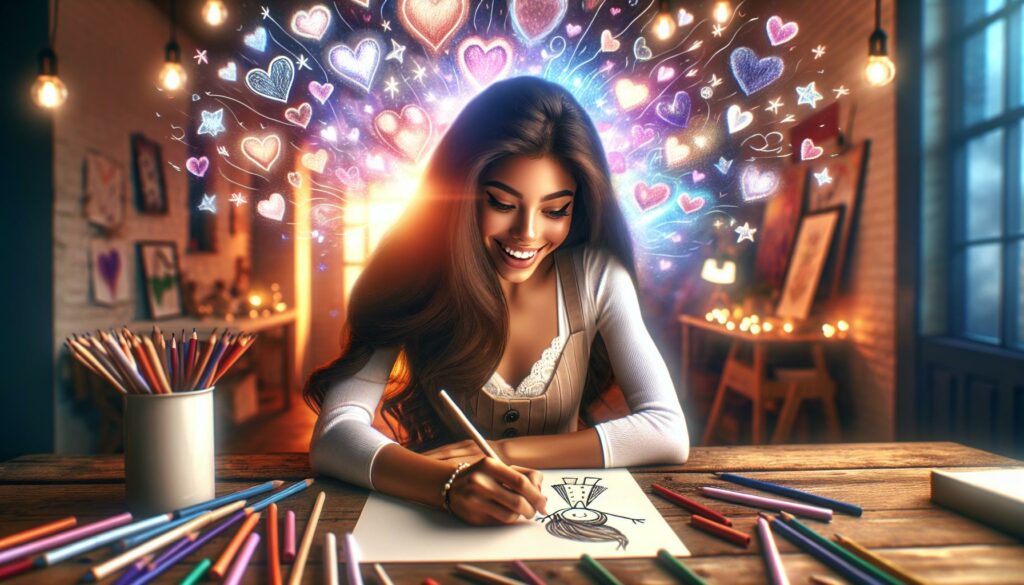Love speaks through art in countless beautiful ways and simple love drawings (dibujos de amor) have become a universal language of affection. These heartfelt sketches capture emotions that words sometimes can’t express letting anyone become an artist of romance regardless of their skill level.
Creating love-themed drawings doesn’t require professional artistic abilities. Whether it’s a cute heart doodle a pair of lovebirds or intertwined initials these simple illustrations carry powerful messages that transcend language barriers. They’ve gained massive popularity on social media where millions share their creative expressions of love through basic yet meaningful artwork.
Facil:pnhdglllkuq= Dibujos De Amor
Easy love drawings transform complex emotions into simple visual elements through basic shapes, lines, and symbols. Common elements include hearts, interlocking initials, roses and cartoon-style couples.
Basic elements of love drawings include:
- Single-line heart shapes
- Stick figure couples holding hands
- Floating heart balloons
- Connected infinity symbols
- Cursive love notes with decorative borders
Popular techniques for creating love drawings:
- Continuous line drawing without lifting the pencil
- Symmetrical designs using folded paper
- Bubble letter styles for names or messages
- Simple shading with cross-hatching
- Dotted patterns for texture effects
Starting points for beginners focus on these foundational shapes:
- Circle hearts using two curved lines
- Cupid’s arrows with straight lines
- Love birds formed from curved “S” shapes
- Rose buds using spiral patterns
- Interwoven rings symbolizing unity
| Drawing Type | Difficulty Level | Time to Complete |
|---|---|---|
| Basic Heart | Beginner | 1-2 minutes |
| Love Birds | Intermediate | 5-7 minutes |
| Rose Design | Intermediate | 8-10 minutes |
| Couple Sketch | Advanced | 15-20 minutes |
| Letter Art | Beginner | 3-5 minutes |
Essential materials include standard drawing tools:
- Pencil (HB or 2B)
- Eraser
- Smooth paper
- Fine-tip markers
- Colored pencils
Creating these drawings involves practicing basic geometric shapes first before combining them into more complex designs. Simple repetition of core elements builds muscle memory for smoother execution.
Essential Materials for Simple Love Sketches

Creating simple love sketches requires specific materials that enhance the drawing experience and final results. These tools enable artists to express their emotions through clean lines and smooth shading.
Basic Drawing Tools
Drawing tools for love sketches include graphite pencils in varied hardness levels (2H, HB, 2B), fine-point black pens (0.3mm-0.8mm) and high-quality erasers. A mechanical pencil with 0.5mm lead provides precise control for intricate details like heart curves or facial features. Quality drawing tools include:
- Mechanical pencils: Staedtler 0.5mm for consistent line weight
- Drawing pens: Micron sizes 01, 03, 05 for outlining
- Kneaded erasers: Faber-Castell for clean removal of mistakes
- Blending stumps: Paper tortillons for smooth shading
- Ruler: 12-inch clear plastic for straight lines
- Pencil sharpener: Manual sharpener for traditional pencils
Paper Selection Tips
Paper selection impacts the quality of love sketches through texture weight and durability. Standard drawing paper weights include:
| Paper Type | Weight (gsm) | Best Use |
|---|---|---|
| Sketch Paper | 70-90 | Practice sketches |
| Bristol Board | 250-300 | Final artwork |
| Mixed Media | 160-300 | Multiple techniques |
- Smooth surfaces: Ideal for precise linework in heart designs
- Medium texture: Provides grip for pencil shading
- Bright white shade: Creates contrast for clean love sketches
- Acid-free composition: Prevents yellowing over time
- Standard sizes: A4 or 9×12 inches for versatility
Step-by-Step Love Drawing Techniques

Drawing love-themed artwork follows specific techniques that transform basic shapes into meaningful expressions of affection. These methods break down complex designs into manageable steps for artists of all skill levels.
Heart Shapes and Variations
Basic heart designs start with two circles placed side by side, connected by diagonal lines that meet at a point. Artists create dynamic variations through size adjustments, overlapping elements, and decorative additions. Simple techniques include:
- Drawing bubble hearts using curved lines and rounded edges
- Creating 3D hearts with shading on opposite sides
- Adding ribbons or banners wrapped around the heart shape
- Incorporating patterns inside heart outlines
- Designing heart chains using connecting loops
- Sketching broken hearts with jagged lines
- Drawing anatomical hearts with simplified details
Cute Couple Sketches
Couple sketches capture intimate moments through simplified figures and expressive poses. The process involves:
- Starting with basic stick figures for body proportions
- Adding circular shapes for heads and curved lines for arms
- Creating chibi-style characters with oversized heads
- Drawing connected hands forming heart shapes
- Sketching matching outfits or complementary elements
- Including shared accessories like umbrellas or scarves
- Positioning figures in classic romantic poses
- Adding facial features with minimal detail
- Creating silhouettes for dramatic effect
Each sketch element builds on fundamental shapes while maintaining clean lines and clear expressions.
Adding Personal Touches to Your Love Art

Personal touches transform simple love drawings into unique expressions of emotion through decorative elements, colors, and shading techniques. These customizations create distinctive artwork that reflects individual style and sentiment.
Decorative Elements
Decorative elements enhance love drawings through strategic placement of patterns and embellishments. Small hearts, stars, or swirls arranged around main elements create visual interest and depth. Floral motifs like roses or daisies add romantic flair when placed at corners or intertwined with text. Banners carrying love messages or important dates personalize the artwork, while dotted lines, ribbons, or lace patterns frame the central design. Geometric shapes like circles or triangles create modern borders that complement traditional love symbols.
Color and Shading
Color application elevates love drawings from basic sketches to vibrant expressions of emotion. Red tones dominate romantic artwork, ranging from soft pink to deep crimson for different emotional intensities. Gradient shading techniques create dimension in heart drawings using colored pencils or markers. Cross-hatching adds texture to shadowed areas while keeping lines clean and controlled. Complementary colors like purple and yellow create dynamic contrasts that draw attention to focal points. Watercolor washes in pastel shades produce soft, dreamy effects perfect for romantic themes.
Common Mistakes to Avoid
Artists often create unbalanced proportions in love-themed drawings by making one side of a heart larger than the other. Drawing guide lines ensures symmetry.
Pressing too hard with pencils leads to dark marks that resist erasing. Light pencil strokes allow easier corrections while maintaining clean lines.
Overcrowding designs with excessive details drowns out the main love elements. Limiting decorative elements to 3-4 per drawing maintains visual clarity.
Here are specific technical errors to watch for:
- Using single continuous lines for complex shapes creates wobbly results
- Skipping basic shapes before adding details leads to disproportionate drawings
- Adding shading before completing outlines causes smudging
- Drawing directly with pen eliminates correction options
Common composition mistakes include:
- Centering every element creates static layouts
- Placing hearts too close to page edges limits space for details
- Making companion elements different sizes breaks visual harmony
- Adding text without planning proper spacing
Color application errors affect final results:
- Mixing too many colors dilutes the romantic theme
- Applying dark colors first restricts lighter shade options
- Using heavy pressure with colored pencils creates patchy coverage
- Blending colors without testing creates muddy effects
- Sketch lightly with 2H pencils for initial shapes
- Use ruler guides for symmetrical elements
- Test colors on scrap paper first
- Leave white space between design elements
- Practice basic shapes separately before combining them
Love drawings offer a beautiful way to express emotions through simple artistic gestures. Anyone can create meaningful artwork by starting with basic shapes and gradually building confidence through practice. The key lies in choosing the right materials understanding fundamental techniques and adding personal touches that make each piece unique.
Whether someone’s creating a quick heart doodle or crafting an elaborate love-themed composition they’ll find joy in the process of bringing their feelings to life on paper. With dedication and attention to detail artists can develop their own style while avoiding common pitfalls that might hinder their creative expression.

